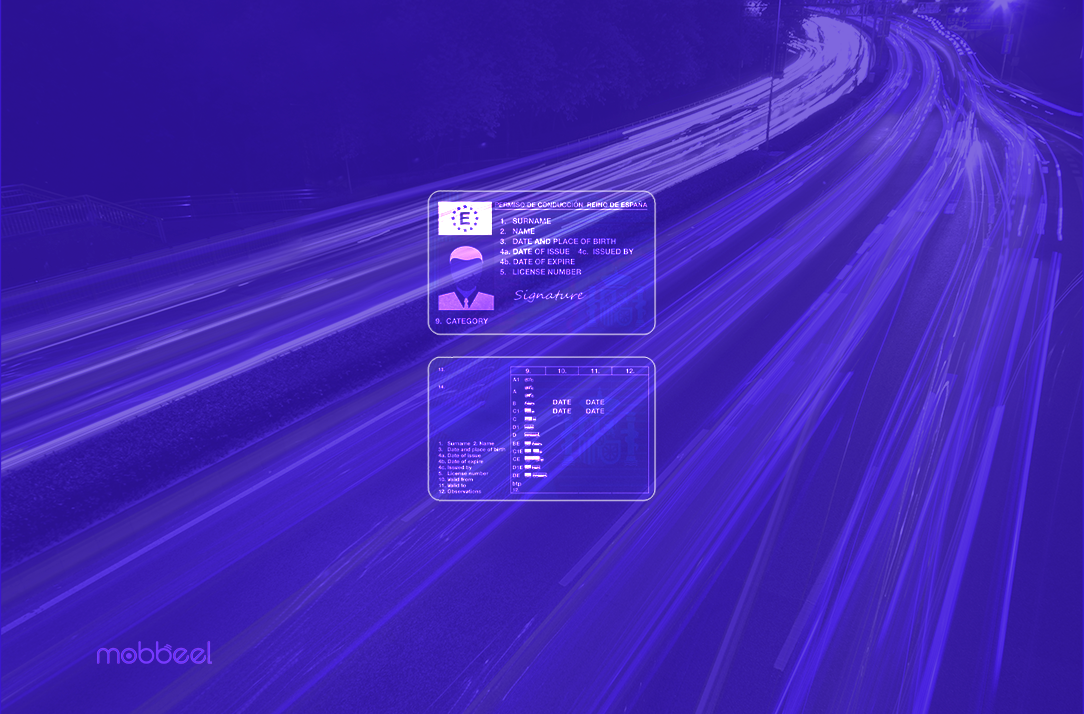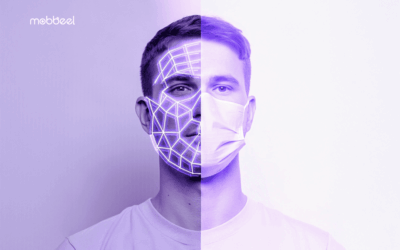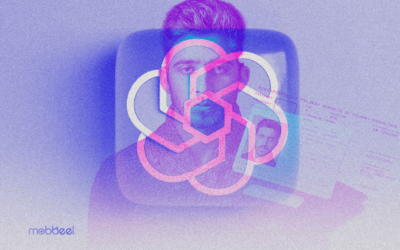We have all been stopped by the police at some point to ask for our driving licence while we were driving. That awkward moment when, even though you know that everything is in order, you get nervous: you look for your licence, hand it over and wait for the officer to check it. In the meantime, you wonder if the next thing you think about will be a breathalyser test, not because you’re afraid of testing positive, but because of the pressure of the moment.
Although this is the first image that comes to mind when you think of a driving licence, the truth is that this document has many functions. In addition to being essential to be able to drive a vehicle, the driving licence is also used as a means of personal identification in different situations, being a valid alternative to the national identity card or passport. Thanks to the information it contains and its official format, it is widely recognised as a reliable document to prove the identity of its legitimate holder.
What is a driving licence?
A driving licence, also known more formally as a driving permit, is an official document authorising a person to drive certain types of vehicles. It is issued by the competent authorities, such as the Dirección General de Tráfico (DGT) in Spain, and contains personal information about the holder, such as their name, date of birth, and photograph, as well as data related to the categories of vehicles they are authorised to drive.
Types of driving licence
Today, there are two main formats for holding a driving licence: the physical format and the digital format.
Physical driving licence
The physical licence is the traditional plastic card that includes all relevant information about the holder and the corresponding authorisations. Its design complies with international standards to ensure its validity in other countries, especially within the European Union, where a unified format is applied.
Digital driving licence
In recent years, the digital driving licence has been implemented through official applications such as miDGT in Spain. This format allows users to carry a digital copy of their driving licence directly on their mobile phone. The digital version has the same legal validity as the physical format. It is especially useful in case of loss of the traditional licence or to facilitate its presentation at controls and formalities.
How do I verify my identity with my driving licence?
The driving licence verification process begins with the capture of the licence data through OCR. This technology scans the document and extracts key information such as personal number, first name, surname, date of issue and expiry and authorised driving categories. Automated extraction ensures accuracy and eliminates human error, even if the document shows signs of wear and tear.
After capture, the data is subjected to automatic validations. These checks the authenticity and validity of the information, including the format of the personal number, the consistency of dates, and the validity of international codes that identify nationality and issuing state.

A critical step in the process is facial matching. The user takes a selfie, which is checked against the ID card photograph using biometric algorithms. It ensures that the person presenting the document is who they claim to be. To reinforce this stage, a proof of life is included. This procedure does not require the user to perform specific actions in front of the camera but only to look at the camera to confirm that the person is physically present and is not an impostor.
Spanish driving licence data fields and validations
The European driving licence has a uniform design in all the countries that make it up, with small variations depending on the place of issue. In this section, we will focus on the Spanish document, which includes several key fields that identify the holder and verify its validity. The main ones are detailed below:
- Personal number: Unique identifier of the holder, equivalent to the DNI, located in field number 5. This number remains constant even after renewal of the document.
- First name and surname: The first name is in field number 2, while the surname is in field number 1.
- Key dates:
- Date of birth: Field number 3.
- Date of issue: Field number 4a.
- Expiry date: Field number 4b.
- Nationality and issuing state: Represented by three-letter codes according to ISO 3166-1 alpha-3.
- Valid licence types: Detailed in the photograph below, these include categories such as A1, B, or C1, together with their issue and expiration dates.
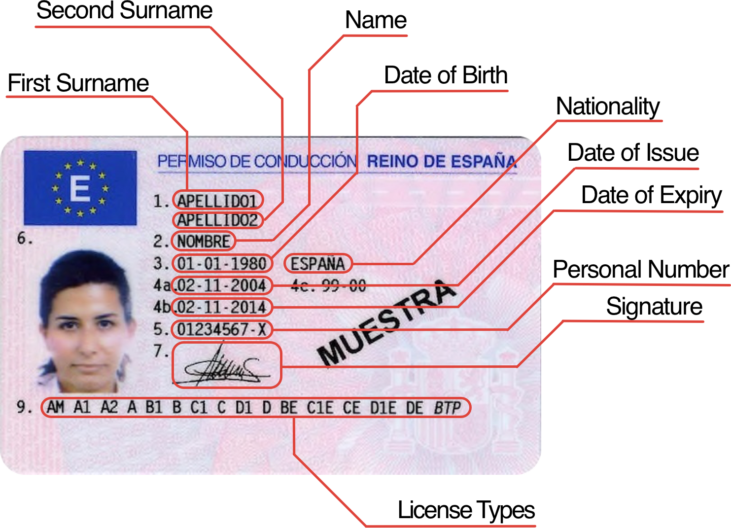
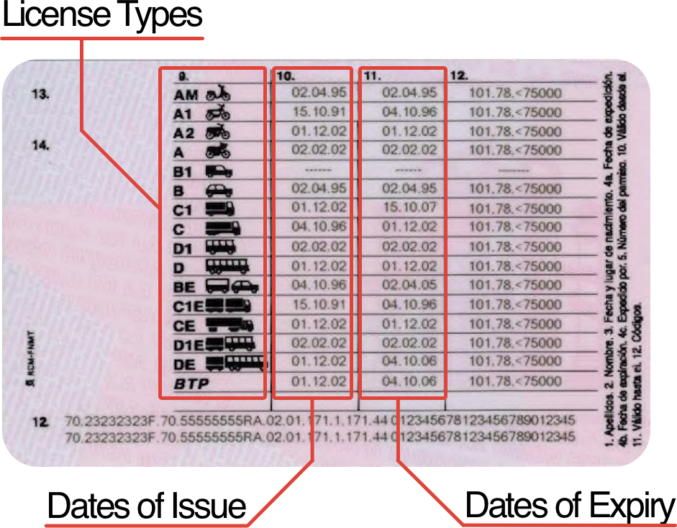
The driving licence includes several validations that guarantee the authenticity of the data and the validity of the document.
These validations are essential to confirm that the information contained in the fields is correct and complies with the required standards. The main ones are described below:
- Validation of the personal number (validationPersonalNumber): Checks the existence and validity of the personal number (DNI) by means of an algorithm that verifies the associated check digit. This validation is exclusive to Spanish documents and ensures that the format is correct.
- Validation of the nationality (validationNationality): Verifies that the three-letter code representing the holder’s nationality matches one of the valid codes established by the ISO 3166-1 alpha-3 standard. This ensures the accuracy of the international representation of the nationality.
- Validation of dates (birth, issue and expiry):
- Date of birth (validationDateOfBirth): Confirms that the date is real and follows the required format (mm-dd-yyyy).
- Date of issue (validationDateOfIssuing): Ensures that the date of issue of the document is valid, consistent and correctly formatted.
- Expiration date (validationDateOfExpiry): Verifies that the expiry date is correctly formatted and true.
Use cases where driving licence verification is needed
The driving licence is used in a wide variety of use cases in the mobility industry where it is necessary to confirm identity for driving. Some of the most common use cases are
Car rental
When you rent a car, rental companies ask you for your driving licence to prove that you are authorised to drive the vehicle in question. This includes both the presentation of the physical licence and, in many cases, the validation of a national identity card or passport.
Ride sharing companies
Ridesharing services also need to verify driving licences to ensure that users meet the legal requirements for driving. These systems, both for ridesharing and per-minute rentals, often use digital tools such as MobbScan to validate the licence quickly and securely before allowing access to the vehicle.
Insurance company procedures
Insurance companies require a driving licence to issue vehicle-related policies. The driving licence check allows them to verify that the driver meets the legal requirements for driving and to determine the applicable coverages.
Access to specific jobs
In jobs where driving vehicles is required, such as delivery drivers or carriers in logistics, driving licence verification is a prerequisite. In addition, the human resources department often checks licence categories to confirm that the applicant is qualified to drive certain types of vehicles.
Security checks at events
At certain events, such as motor competitions or car races, a driving licence may be required as identification for participation.
Contact us if you are interested in a driving licence verification solution that uses OCR technology for data extraction.

